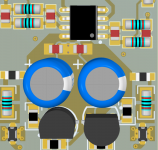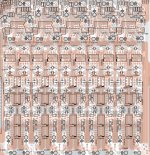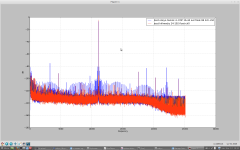Not even a little scope? [--snip--]
These ultra-everything opamps are often quite fast (like 50MHz GBW) so they require attention to decoupling and layout. Fast opamps are quite sensitive to inductance in their power supplies. So, for example, it is quite common to see people here replace an opamp like a NE5532, which is slower, with a fancy LME49xxx. But... if the board was designed for a NE5532 or a 4580 or something like that, there will be some electrolytic decoupling caps somewhere on the board, with quite long power traces to the opamps. This is fine with slower opamps, but not for 50MHz opamps. Especially at the output of a DAC, where the signal contains high frequency, the fast opamp will process it, output it, and to do so it will draw some high frequency current from its power supplies. If there are no decoupling MLCCs and ground plane to get a low inductance power supply, this will result in excess HF noise on the rails and in the output, ringing, and worse settling time. Also the internal compensation of these amps is referred to the power supply, so if it has extra inductance, stability can be compromised.
there's a nice series of articles about this by Kendall Castor Perry:
https://www.edn.com/yet-more-on-dec...ing-the-complete-op-amp-power-supply-circuit/
Basically, if the opamp is relatively fast (like 20MHz or more), then I'm not interested in opinions about how it sounds in a circuit if I can't see the layout, because if the layout and decoupling are not proper, then the result is not the "sound" of the opamp (if it has one...) but rather the result of the interaction of a PCB and its parasitics with the opamp. And that provides no useful data, since every bad PCB is different.
[--snip--]
Hi peufeu,
I'm looking at your article link now. The article seems to indicate that the Tantalum regulator capacitor provides the clean & fast settling time in picture 6.9., with LT1632 -- https://www.edn.com/wp-content/uploads/media-1064473-bypass6-fig69t.jpg
He seems to be showing evidence that Tantalum capacitors provide a smoother response in the settling time, as long as you zoom in close enough......
He stated in picture 6.5, using LT1763 -- https://www.edn.com/wp-content/uploads/media-1064463-bypass6-fig65t.jpg, that after employing the Tantalum capacitor "The equivalent trace for the LT1723 is now so clean and fast that it's not worth printing".
The link you provided today seems to provide some evidence that Tantalum capacitors cause a faster, cleaner & smoother settling time when you zoom in far enough, compared to ceramic capacitors. Ok, so if Tantalum capacitors are superior when you zoom in like this, then why not just fill the entire PCB with Tantalum capacitors where it's possible to use them?
Either way, nice article. I'll check it again later & save it for the future, like, if I ever try to upgrade an amplifier to the real maximum sound then I'm supposed to check the settling time & there is no ringing etc etc I get it.
Any real amplifier has all the zooming in showing clean settling time just like in the article you linked.
[--snip--]
if the opamp is relatively fast (like 20MHz or more), then I'm not interested in opinions about how it sounds
[--snip--]
Hi peufeu,
The AD828 is 130 Mhz so then you're not interested in how it sounds.
Hmm, I don't need scopes & lab equipment to check what I hear, I just look at the datasheets, although when it's possible then I'll re-purchase the ES9018 desktop DAC, order it with AD828 in the line-out & measure the line-out output to see if there is any strange effects, so your posts here inspired me enough to like, sooner or later confirm the ringing & settling time, etc.
Nevertheless I know you're not interested, although in my perception & if I make a list of DAC + Line-out, then ES9018 + AD828 is in my perception around the top of the list where I could enjoy many albums and many movies with this stellar sound (with the correct implementation* in xyz PCB circuit).
*I don't have any 'scope pictures to show the implementation was correct, just in my perception I can rank what is amazing sound & what is not interesting sound which I turn off & put in the wardrobe to gather dust.
Hi Kastor L,
You do realize that NOS DACs absolutely require a vicious 7th order (or higher order) filter - right?
Why is it that idiots who build or buy NOS DACs do not include the necessary filters? Do you know why there is a nasty filter there???? Mostly to keep the 44.1KHz sampling frequency out of your system!
[--snip--]
Hi anatech,
If you're referring to my comments on the PCM1704 then I was referring to PCM1704 running in oversampling mode, or with applied external oversampling, i.e. the 1704 at top performance, versus ES9018 at top performance, why do they sound different, that's all. I just checked the datasheet of the 1704 which says it has 8x oversampling, which could be improved further with software, although personally I don't think oversampling & upsampling is important. For example, in my Samsung Galaxy phone when I turn on upsampling I can almost not hear any difference at all, any tiny difference at the edge of audible then it's not important.
In addition I purchased one of the non-oversampling NOS DAC's (TDAnnnn something) from China & I didn't like it & it quickly hit the wardrobe shelf.
Last edited:
You need to read some history of Markw4 claims. Then, you may want to take your "non sequitur line" and shove it.
Tss, tss ...
Essentially it is further corrobation for the "non sequitur", isn't it?
Hi anatech,
If you're referring to my comments on the PCM1704 then I was referring to PCM1704 running in oversampling mode, or with applied external oversampling, i.e. the 1704 at top performance, versus ES9018 at top performance, why do they sound different, that's all. I just checked the datasheet of the 1704 which says it has 8x oversampling, which could be improved further with software, although personally I don't think oversampling & upsampling is important. For example, in my Samsung Galaxy phone when I turn on upsampling I can almost not hear any difference at all, any tiny difference at the edge of audible then it's not important.
Don't you mean the PCM1794?
The biggest problem with feedback is usually not having enough of it.
Agree. Low loop gain and very small bias current of transistor output in class B. You will hear crossover distortion which have high order distortion.
Ok, so if Tantalum capacitors are superior when you zoom in like this, then why not just fill the entire PCB with Tantalum capacitors where it's possible to use them?
It's not about the material, it's about the ESR. Basically the take-away point from this article is: a smooth power supply impedance, without sharp resonance peaks, is desirable. Also it should not change much with load current, and impedance wiggles in the audio band are best avoided. But you can implement it any way you want. For a hobby project, it does not cost much more to do it right, maybe a 10 cent electrolytic cap and a few 1 cent resistors, and layout. In fact, it can even work better with less parts, since the first step is to remove all the 100nF MLCCs which are in parallel with 1µF MLCCs.
Personally I don't like tantalum caps, they're much more expensive than electrolytics, they have no self-healing mechanism and fail short circuit, and they have that weird frequency-dependent ESR. But they're small, and "thin" is fashionable.
I've attached the whole article series in pdf, because EDN seems to not want to display all of them at the moment. They're excellent, and well written.
Attachments
You have good ears. You should know the answers to those questions.
Hi johnego,
I just know that 5 desktop DAC's using different chips, which all measure identical in THD, using scientifically correct implementation (without ringing, etc), all sound like 5 different DAC's.
So I don't know the answer to the question actually.
Like I can't zoom in into the inside of the DAC & hear the exact reason.
Anyway the PCM1792 & ES9018 are designed completely different with a different circuit, so
PCM1792A -> scientifically correct PCB -> line-out AD828 / THS4032 -> transparent class-A amp -> speaker
ES9018 -> scientifically correct PCB -> line-out AD828 / THS4032 -> transparent class-A amp -> speaker
Then the difference is inside the ES9018 chip & inside the PCM1792A chip.
Ok I sort of answered my question. http://itisamystery.com/
<snip> You say: "since we don't know if such a person exists or not, we cannot draw any general conclusion about the ability to hear 0.0001% distortions", I say "until a person confirmed to hear 0.0001% distortions shows up, we can happily and productively ignore this possibility and it's consequences".
That's in my view the difference between theory and practice. Last time I've checked, this forum is about practice and applied sciences, not about investigating theoretical possibilities (and nitpicking about, which I just did myself).
Now, you're trying to put words in _my_ mouth.
You started with a question about the relevance if one person's ability was established (beyond reasonable doubt) and now you're talking about "since we don't know if such a person exists...." .
I said, the finding of one person (as done in your example) is relevant, if someone posited that it would be impossible. Practical relevance is likely due to basic considerations; if you've found one, it is more likely that there are more out there, than that you've found the single one in the world.
Obviously, it would be different, if someone tested already half of the world's population and still have found only one.
Similar reasoning about results of small sample size experiments; it is more likely that they do not reflect small subgroups of the population although we are able to calculate promising looking confidence intervals. Therefore the reminder, that the calculated probabilities only reflect the properties of the procedures not true probabilities that the estimations are correct.
Last edited:
Don't you mean the PCM1794?
Hi rfbrw,
I only heard the PCM1792 / PCM1792A (it's really great) & I read many comments in the internet where people keep saying the PCM1704 is superior to the 1794/1795/1792 so for some reason PCM1704 is sort of still the most famous chip.
[--snip--]
I've attached the whole article series in pdf,
[--snip--]
Ok you really know a lot about PCB design.
The AD828 is 130 Mhz so then you're not interested in how it sounds.
That depends: if the layout and decoupling are good, then the resulting performance will be a good representation of what the opamp can do, and I'm interested.
Otherwise, "how it sounds" is really "how it interacts with a particular non-optimum layout" so that provides little information about the opamp. If it sounds and measures good with a really bad layout, it can give information that the opamp is tolerant about these things, which is nice.
For example, here's an opamp layout that works:

- Both rails have 10µF MLCCs on the same side of the opamp connected to GND plane at the same point to avoid injecting distorted supply current into the ground plane through the caps
- Same for electrolytic caps
- Same for TL431's
- No ringing
On that board there was only one opamp, so it got its own personal power supply. But if there were a lot of them, I'd add a few resistors to dampen resonance between the decoupling MLCCs, that's all.
Nevertheless I know you're not interested, although in my perception & if I make a list of DAC + Line-out, then ES9018 + AD828 is in my perception around the top of the list
Alright, please show a photo of the board.
In addition I purchased one of the non-oversampling NOS DAC's (TDAnnnn something) from China & I didn't like it & it quickly hit the wardrobe shelf.
Yeah I tried that too. Where did the treble go? It sounded a lot better with 192k sample rate and software oversampling on the PC.
i.e. the 1704 at top performance, versus ES9018 at top performance, why do they sound different, that's all.
It's easy to screw up a DAC so when comparing DACs what you're really comparing is one implementation of one DAC versus one implementation of the other DAC. So there is a tendency for DAC chips that are more picky about implementation to suck more in the final result.
For example, if you listen to Onkyo TX-NR-905 which uses PCM1792:

You would conclude that it sucks. But that's not the fault of PCM1792, it's the board, the whole design is an abomination, everything is wrong from the SPDIF input connector to the output RCA.
And since there is the word "measurement" in the topic...

I'm sure Andrea will like this jitter plot lol.
Last edited:
Hi rfbrw,
I only heard the PCM1792 / PCM1792A (it's really great) & I read many comments in the internet where people keep saying the PCM1704 is superior to the 1794/1795/1792 so for some reason PCM1704 is sort of still the most famous chip.
The PCM1704 has no built-in oversampling filter like the PCM179x family. It is from the PCM63/PCM1702 family. It is multibit unlike the PCM179x dacs.
The PCM1704 has no built-in oversampling filter like the PCM179x family. It is from the PCM63/PCM1702 family. It is multibit unlike the PCM179x dacs.
How about the R2R & current segment architecture, do people say these two affect SQ ?
For example, if you listen to Onkyo TX-NR-905 which uses PCM1792:
View attachment 953499
You would conclude that it sucks. But that's not the fault of PCM1792, it's the board, the whole design is an abomination, everything is wrong from the SPDIF input connector to the output RCA.
And since there is the word "measurement" in the topic...
View attachment 953502
I'm sure Andrea will like this jitter plot lol.
It's interesting the famous company Onkyo with high-tech designers can make such a terrible design of a DAC with terrible measurement as well, it just shows that these audio companies including Onkyo are just normal people like us =)
So there is a tendency for DAC chips that are more picky about implementation to suck more in the final result.
It seem you have very good engineering knowledge.
Ordinary people always use statistic only to make a conclusion, because they do not know about engineering, like the implementation.
It's interesting the famous company Onkyo with high-tech designers can make such a terrible design of a DAC with terrible measurement as well, it just shows that these audio companies including Onkyo are just normal people like us =)
Yeah, I was surprised, it's the flagship model, expensive DAC chips, and there is no ground plane on this DAC board. 2 layers only. Tons of HF noise anywhere I stuck a scope probe.
How about the R2R & current segment architecture, do people say these two affect SQ ?
As far as the PCM1704 is concerned the two go together and never having listened to the PCM1704, I couldn't say.
It's interesting the famous company Onkyo with high-tech designers can make such a terrible design of a DAC with terrible measurement as well, it just shows that these audio companies including Onkyo are just normal people like us =)
Not all engineers at big company have very good knowledge of engineering. It is the reason, why someone like John Curl have a job
I have a friend that hire several big company, to design speaker as consultant engineer. His main job is software engineer, but he know how measure and have very good knowledge in audio. He won online quiz to matching 3 kind measurement of 3 speakers with recording of those speakers.
anywhere I stuck a scope probe.
How many potential Onkyo buyers have a probe or even know what a ground plane is ?
Jacob, I got an aha moment a couple of days ago. Seems your brain and his are wired differently too. Just like in my case, I do not think that there exist a significant probability for you to give intelligible explanation on some subjects beyond EE core to him.Now, you're trying to put words in _my_ mouth...
- Status
- Not open for further replies.
- Home
- Member Areas
- The Lounge
- Sound Quality Vs. Measurements